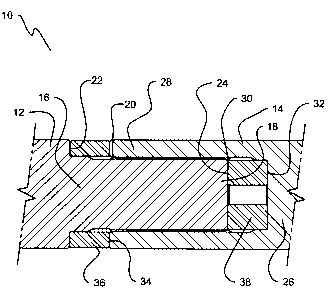Some of the information on this Web page has been provided by external sources. The Government of Canada is not responsible for the accuracy, reliability or currency of the information supplied by external sources. Users wishing to rely upon this information should consult directly with the source of the information. Content provided by external sources is not subject to official languages, privacy and accessibility requirements.
Any discrepancies in the text and image of the Claims and Abstract are due to differing posting times. Text of the Claims and Abstract are posted:
| (12) Patent Application: | (11) CA 2591888 |
|---|---|
| (54) English Title: | THREADED CONNECTION |
| (54) French Title: | RACCORD FILETE |
| Status: | Deemed Abandoned and Beyond the Period of Reinstatement - Pending Response to Notice of Disregarded Communication |
| (51) International Patent Classification (IPC): |
|
|---|---|
| (72) Inventors : |
|
| (73) Owners : |
|
| (71) Applicants : |
|
| (74) Agent: | DOUGLAS B. THOMPSONTHOMPSON, DOUGLAS B. |
| (74) Associate agent: | |
| (45) Issued: | |
| (22) Filed Date: | 2007-06-11 |
| (41) Open to Public Inspection: | 2008-12-11 |
| Examination requested: | 2009-03-27 |
| Availability of licence: | N/A |
| Dedicated to the Public: | N/A |
| (25) Language of filing: | English |
| Patent Cooperation Treaty (PCT): | No |
|---|
| (30) Application Priority Data: | None |
|---|
A threaded connection includes an externally threaded pin connection and an
internally threaded box connection. The pin connection has a proximate end, a
distal end, a
pin shoulder at the proximate end and a distal contact surface at the distal
end. The box
connection has a proximate end, a distal end, an internal contact surface at
the proximate end
and an external shoulder at the distal end. At least one deformable element is
positioned
either between the pin shoulder of the pin connection and the external
shoulder of the box
connection or between the distal contact surface of the pin connection and the
internal contact
surface of the box connection. The deformable element is of a softer material
than that of the
pin connection and the box connection, such that the deformable element
deforms in response
to a momentary torque overload.
Note: Claims are shown in the official language in which they were submitted.
Note: Descriptions are shown in the official language in which they were submitted.

2024-08-01:As part of the Next Generation Patents (NGP) transition, the Canadian Patents Database (CPD) now contains a more detailed Event History, which replicates the Event Log of our new back-office solution.
Please note that "Inactive:" events refers to events no longer in use in our new back-office solution.
For a clearer understanding of the status of the application/patent presented on this page, the site Disclaimer , as well as the definitions for Patent , Event History , Maintenance Fee and Payment History should be consulted.
| Description | Date |
|---|---|
| Application Not Reinstated by Deadline | 2011-06-13 |
| Time Limit for Reversal Expired | 2011-06-13 |
| Deemed Abandoned - Failure to Respond to Maintenance Fee Notice | 2010-06-11 |
| Letter Sent | 2009-04-07 |
| Request for Examination Requirements Determined Compliant | 2009-03-27 |
| Request for Examination Received | 2009-03-27 |
| All Requirements for Examination Determined Compliant | 2009-03-27 |
| Application Published (Open to Public Inspection) | 2008-12-11 |
| Inactive: Cover page published | 2008-12-10 |
| Inactive: Adhoc Request Documented | 2008-01-02 |
| Inactive: First IPC assigned | 2007-11-30 |
| Inactive: IPC assigned | 2007-11-30 |
| Inactive: IPC assigned | 2007-11-30 |
| Inactive: IPC assigned | 2007-11-30 |
| Inactive: IPC assigned | 2007-11-30 |
| Revocation of Agent Request | 2007-11-16 |
| Appointment of Agent Request | 2007-11-16 |
| Application Received - Regular National | 2007-07-20 |
| Filing Requirements Determined Compliant | 2007-07-20 |
| Inactive: Filing certificate - No RFE (English) | 2007-07-20 |
| Correct Applicant Requirements Determined Compliant | 2007-07-20 |
| Abandonment Date | Reason | Reinstatement Date |
|---|---|---|
| 2010-06-11 |
The last payment was received on 2009-03-27
Note : If the full payment has not been received on or before the date indicated, a further fee may be required which may be one of the following
Please refer to the CIPO Patent Fees web page to see all current fee amounts.
| Fee Type | Anniversary Year | Due Date | Paid Date |
|---|---|---|---|
| Application fee - standard | 2007-06-11 | ||
| Request for examination - standard | 2009-03-27 | ||
| MF (application, 2nd anniv.) - standard | 02 | 2009-06-11 | 2009-03-27 |
Note: Records showing the ownership history in alphabetical order.
| Current Owners on Record |
|---|
| ORREN JOHNSON |
| Past Owners on Record |
|---|
| None |